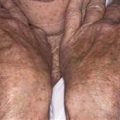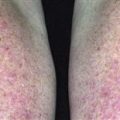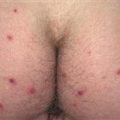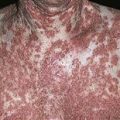36
Psoriasis: hands and feet
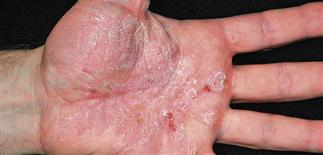
Psoriasis of the palms may be difficult to discern from hand eczema. The silvery, dense, scaling plaques are also seen in chronic hand eczema.

This same presentation of defined round scaling plaques of the dorsum is seen in nummular eczema.
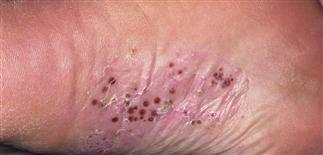
Pustular psoriasis of the palms and soles. Lesions are localized or may involve the entire palms or soles.
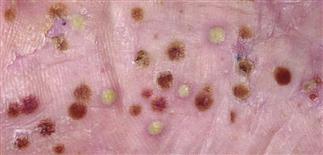
Pustular psoriasis lesions resemble dyshidrotic eczema. Pustules evolve to deep-set brown spots and then into scaling papules.
DESCRIPTION
Chronic, inflammatory disease due to abnormal T-lymphocyte function. Affects skin, scalp, joints, nails.
HISTORY
• Chronic course; exacerbations, remissions. • Genetic predisposition. Environmental triggers include stress, physical trauma, Streptococcus infections, drugs (lithium, beta-blockers, antimalarials, corticosteroid withdrawal), HIV. • Nail involvement: 10–50% (see Psoriasis: nails). • Psoriatic arthritis (rheumatoid factor-negative): 7–20%. May precede skin disease.
PHYSICAL FINDINGS
Most common: chronic plaque psoriasis (see Psoriasis: lesions). Extent highly variable. Other presentations below. • Guttate. Common initial presentation in children; follows group A streptococcal pharyngitis. Sudden appearance of 0.3- to 1.0-cm papules primarily on trunk, extremities. Spares palms, soles. • Pustular. Rare, severe, unstable. Sterile pustules arise on red base, coalesce to form pus lakes. Erythema progresses in waves with desquamation; patient may appear toxic with fever, skin pain. Generalized forms serious, potentially fatal. Oral steroid withdrawal may precipitate. • Erythrodermic. Uncommon. May be initial presentation or evolve from chronic plaque disease. Localized progressing to generalized erythema, little scale. Oral steroid administration or withdrawal may precipitate. May appear toxic (chills, skin pain). • Pustular psoriasis of palms and soles. Chronic, localized, recurrent, treatment-resistant. Sterile pustules evolve from red base on palms, instep. Pustules do not rupture but turn dark brown, scaly. Often painful, limiting mobility. • Scalp psoriasis. Common. Scale may be very thick, anchored by hair. Plaque may extend beyond hairline. Itching varies. • Intertriginous (inverse). Flexural or intertriginous areas: gluteal fold, axillae, under breasts, groin and genitalia. Smooth, red, sharply defined plaques with macerated surface. Superimposed candida infection in diabetic patients and with topical steroids.
TREATMENT
Treatment similar to that for chronic plaque psoriasis, with specific considerations. • Guttate psoriasis. Treat streptococcal infection with penicillin or equivalent. Skin lesions best treated with triamcinolone 0.1% cream b.i.d. and narrowband ultraviolet B therapy. • Pustular psoriasis. Requires specialist care by dermatologist. Pustular flares respond to Neoral or Soriatane. Ultraviolet B and psoralen plus ultraviolet A useful adjunctive therapies. • Erythrodermic psoriasis. Best managed with Neoral, Soriatane, methotrexate. Ultraviolet therapy and topical steroids helpful adjunctive therapies. • Intertriginous (inverse) psoriasis. Best managed with lower-potency group V topical steroids to minimize atrophy risk. Use in cycles (e.g. b.i.d. for 10–14 days, stop of 10–14 days). • Scalp psoriasis. Treatment with tar (T-Gel, etc.) or salicylic acid shampoos removes some scale. Diffuse scale: apply Derma-Smoothe FS oil to scalp at bedtime, cover with shower cap. Steroid gels (e.g. Lidex, Temovate, Topicort), steroid foams (Olux, Luxiq), or solutions (Cormax) penetrate hair into scale. Dovonex solution 60 cc b.i.d. on weekdays as tolerated.


